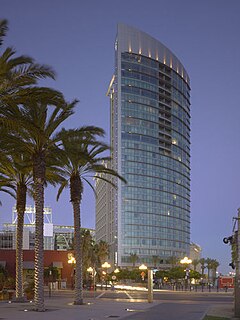
Pembroke was the establishing county town of Pembrokeshire in Wales. Pembroke still features a number of historic buildings, town walls and complexes. It is a community and one of the larger towns in the county with a population of 7,552.

A manor house was historically the main residence of the lord of the manor. The house formed the administrative centre of a manor in the European feudal system; within its great hall were held the lord's manorial courts, communal meals with manorial tenants and great banquets. The term is today loosely applied to various country houses, frequently dating from the late medieval era, which formerly housed the gentry.

Gwydir Castle is situated in the Conwy valley, Wales, a mile to the west of the ancient market town of Llanrwst and 1.5 miles (2.4 km) to the south of the large village of Trefriw. An example of a fortified manor house dating back to c1500, it is located on the edge of the floodplain of the river Conwy, and overlooked from the west by the now-forested slopes of Gwydir Forest.

Laugharne Castle is a castle in the town of Laugharne in southern Carmarthenshire, Wales. It is located on the estuary of the River Tâf and was originally established in 1116. It was rebuilt as a Norman stronghold in 1215 and has seen many alterations over time, becoming a Tudor fortified manor house in the sixteenth century. It changed hands twice during the English Civil War, being eventually captured by Parliamentary forces in 1644.
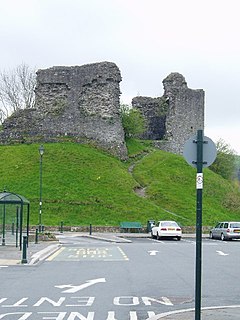
Llandovery Castle is a late thirteenth-century, Grade II*-listed, castle ruin in the town of Llandovery in Carmarthenshire, Wales. It occupies a knoll overlooking the River Towy and the land surrounding it. The Normans built a castle in the current location in the early twelfth century and this was rebuilt in stone. It was burnt in the early sixteenth century and never repaired.

Treago Castle is a fortified manor house in the Parish of St Weonards, Herefordshire, England. Built c.1500, it was recorded as a Grade I listed building on 30 April 1986—based on its extant medieval architecture, quadrangle courtyard layout and defensive wall corner towers. Digging on the site revealed solid bedrock, conflicting rumours of a previously-filled moat.

Haverfordwest Castle is a castle located in the town centre at Haverfordwest, Pembrokeshire, south Wales, located in a naturally defensive position at the end of a strong, isolated ridge. The castle was established during Norman times in 1120 but much of the architecture remaining today is dated to 1290. For centuries the castle was an English stronghold. There are several other notable castles in area; Wiston Castle lies 6 miles (9.7 km) to the northeast and Pembroke Castle lies 12 miles (19 km) to the south.
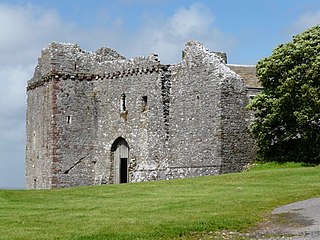
Weobley Castle is a 14th-century fortified manor house on the Gower Peninsula, Wales, in the care of Cadw. The castle overlooks Llanrhidian saltmarshes and the Loughor estuary.

Featherstone Castle, a Grade I listed building, is a large Gothic style country mansion situated on the bank of the River South Tyne about 3 miles (5 km) southwest of the town of Haltwhistle in Northumberland, England.

The Château de Vitré is a medieval castle in the town of Vitré, in the Ille-et-Vilaine département of France.

Parke’s Castle is a plantation era castle situated on the banks of Lough Gill, in County Leitrim, Ireland. Originally an earlier fifteenth-century O'Rourke castle, it came into the possession of Sir Roger Parke, who, by 1628, had completed his fortified manor house at the centre of the older Gaelic castle.

Castlemartin is a village in the Castlemartin Hundred, Pembrokeshire, Wales. It is part of the community of Stackpole and Castlemartin, after amalgamating with Stackpole in 2012, within the Pembrokeshire Coast National Park. The village is on a sandstone ridge, 5 miles (8.0 km) southwest of Pembroke, 4 miles (6.4 km) southeast of Angle, and reached on the B4319 road.

Rosyth Castle is a fifteenth-century ruined tower house on the perimeter of Rosyth Naval Dockyard, Fife, Scotland.

Pujols is a commune in the Lot-et-Garonne department in south-western France.
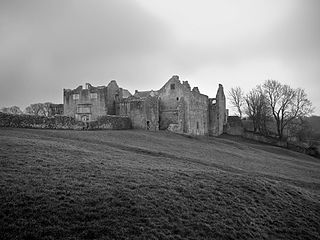
Old Beaupre Castle is a ruined medieval fortified manor house located in the community of Llanfair, outside Cowbridge in Wales. It is known in historic documents under the names Beawpire, Bewerpere, Bewpyr and Y Bewpur. It is a Grade I listed building and is presently under the care of Cadw. It can be visited free of charge all year round by members of the public.
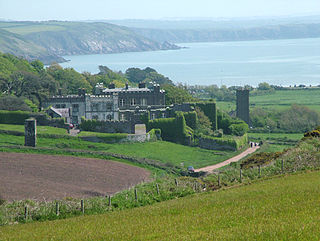
Dale Castle is a 13th-century castle located close to the village of Dale in Pembrokeshire, Wales. In 1910, part of the castle was removed and other parts were incorporated into a new private dwelling house, built in the style of a fortified manor house.

Lissingen Castle is a well-preserved former moated castle dating to the 13th century. It is located on the River Kyll in Gerolstein in the administrative district of Vulkaneifel in Rhineland-Palatinate, Germany. From the outside it appears to be a single unit, but it is a double castle; an estate division in 1559 created the so-called lower castle and upper castle, which continue to have separate owners. Together with Bürresheim and Eltz, it has the distinction among castles in the Eifel of never having been destroyed.
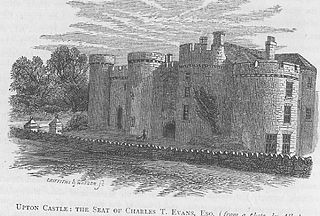
Upton Castle is a 13th-century castle or fortified manor house with an associated chapel, located near Cosheston, Pembrokeshire in Wales. Although in private ownership, the gardens are open to the public.

Paterchurch Tower is a Grade I-listed medieval fortified tower in Pembroke Dock, Pembrokeshire, Wales. It received its name from one of the families that owned the land. While its exact function is not known, it probably served as a pele tower for the manorial complex in which it was situated.




